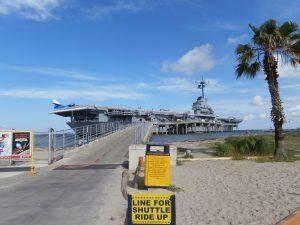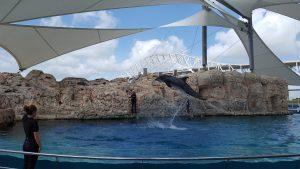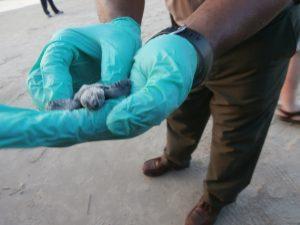All I knew about Corpus Christi, Texas, before I visited my step-daughter, Michelle, and her family there this summer was that it was a seaside vacation town on the Gulf of Mexico. I expected to find a typical American beach resort, replete with masses of tourists and messy hedonistic vitality. And, that’s what I found – in part.
Corpus Christi certainly deserves its reputation as a fun and entertaining place to vacation. And, despite its size and its prominence as a south Texas cultural, industrial and tourist hub, I also discovered that, if you get off the beaten path, you will find much more. The area offers a rare combination of culture, history, industry, tourism, and conservation – Corpus Christi really is unique!
Popular Things to Do and See in Corpus Christi
We started off by visiting a few of the well-known tourist-oriented attractions, like the USS Lexington Naval Aviation Museum, the Museum of Science and History, and the Texas State Aquarium. And they did not disappoint!
USS Lexington Naval Aviation Museum:

Commissioned in 1943, the USS Lexington is a World War II-vintage Essex Class aircraft carrier that has been converted into a naval aviation museum. This vessel served the United States longer than any other Essex Class carrier in history, and was the oldest working carrier in the United States Navy when finally decommissioned in 1991.
In 1992, a community-wide effort succeeded in permanently harboring the ship off of North Beach on Corpus Christi Bay, It was ultimately converted into a museum, educational facility, memorial, and popular cultural attraction.
More recently, the producers of the movie, “Pearl Harbor” used this vessel for the on-ship filming of their 2001 work.
We began our tour by cruising around the immense flight deck of the vessel, which featured various United States war aircraft from over the years. Walking the narrow and ominous “plank” at the end of this huge craft to view the waters below, and having to dodge crews moving some of the aircraft around on the deck, were stark reminders that this was once a vessel embroiled in some of our nation’s major naval battles.
A visit to the Navigation Bridge and anti-aircraft Guns provided a glimpse of what being in the midst of a raging WWII maritime conflict might look like. And, exploring the bowels of the ship allowed us a peek into the day-to-day life of the crew onboard. Of particular interest were the Ready Room, where the pilots prepared for battle, the awe-inspiring size of all the anchor machinery, and the small, but eerily opulent Captain’s Quarters, complete with private dining room and Captain’s Galley.
The sophistication of the entire operation was astounding. One could almost imagine the intense, but systematic burst of activity that must have taken place inside this immense ship during the heat of battle.
Corpus Christi Museum of Science and History:
The Corpus Christi Museum of Science and History was established in 1952, to provide and promote cultural awareness, public education, and science exploration.
The museum’s exhibits contain hundreds of thousands of artifacts and historically significant items typical of what one finds in many science and history museums. But, what I found most interesting was the Shipwreck display, which brought to life a romantic vision of the swashbuckling times of yore that I read about when I was young.
This exhibit highlights artifacts found in the wreck of the Spanish Carrack cargo ship, the San Esteban, which ran aground near neighboring Padre Island in the spring of 1554. These objects include the stern section of the keel with part of the sternpost, wrought-iron anchors, cannons, ammunition, tools, ship’s fittings and fastenings, and silver coin and bullion. The exhibit also features the world’s oldest date-confirmed mariner’s astrolabe – (1545).
The museum also features a Science Center, geared primarily for children. This highly interactive display entertains and educates with larger than life exhibits of such subjects as chemistry, particles, cells, DNA, engineering, math, physics, space and astronomy, and paleontology.
I spent most of my time investigating the large momentum-related interactive displays while the kids raced up and down the musical piano key staircase and erected interesting structures with the large, variously shaped building blocks.

The Texas State Aquarium offers visitors the opportunity to view ocean and coastal life up close.
The Texas State Legislature designated the aquarium as the “Official Aquarium of Texas” in 1986, and in 1993, it became a federally-permitted animal rehabilitation facility.
Its mission is to “engage people with animals, inspire appreciation for our seas, and support wildlife conservation.” The facility also promotes conservation of the Gulf of Mexico and the Caribbean Sea in general, as well as the rehabilitation of regional wildlife.
The Aquarium features many exciting, entertaining and educational exhibits, but the highlights for me were the dolphin show and the stingray exhibit.
At Dolphin Bay, we watched with great amusement the phenomenal aerial and aquatic acrobatics of these graceful, intelligent creatures as the trainers playfully put them through their routines – a few delectable fish as a well-earned reward. At the end of the show, the dolphins, in turn, rewarded us with a big splash into the audience as the finale.
At Stingray Lagoon, intrepid spectators are encouraged to pet and even feed these interesting and often misunderstood relatives of sharks. We squealed nervously as we took turns placing a small fish between our fingers, allowing the hungry rays to swim by and quickly snatch the tasty snacks from our grasp. I don’t know who was more excited, the rays or us!
What makes Corpus Christi Really Different?
Baby Sea Turtle Release

Although I really enjoyed the museums and the aquarium, the true highlight of my trip was watching the sea turtle hatchling release on Malaquite Beach at the Padre Island National Seashore on North Padre Island.
This is where I got to see just how unique and wild Corpus Christi really is!
We awoke early one morning and joined the eager crowd that gathered to watch the drama of a true conservation success story unfold – the releasing of newly hatched Kemp’s ridley sea turtles into the wild. The Kemp’s ridley is the smallest and most critically endangered species of sea turtle in the world.
The turtles spend most of their time in the open ocean and gulf waters, but the females come ashore to nest and lay their eggs in sandy beaches like those found on Padre Island. They are the only species of sea turtle that routinely lays eggs during daytime hours. And, they often do so en masse, during a fascinating spectacle called an arribada (“arrival” in Spanish).
The nesting season runs from April to Mid-July. And, sometime between about 45 to 70 days after being laid, the eggs hatch, and the little ones make the perilous journey across the beach, into the surf, and eventually to the open ocean, desperately dodging predators along the way. Their survival at this point depends on sheer numbers and making it to the water before the hungry seagulls and crabs can snatch them up.
Mature females (10-14 years old) that survive will eventually return to the beach on which they were born to lay their own eggs. When these new hatchlings emerge, they must make their way across the sand to the ocean, just as their mothers did, in order to imprint the scents of that particular beach on the females. In this way, they will know where to return to continue this cycle of life that has endured for over 45 million years. Fascinating!
And, we were fortunate to witness this amazing beach crossing spectacle ourselves!
Before they led us down to the beach to watch the release, our hosts gave us information about the project, and the turtles themselves. They also told us how we could help during the release by simply shuffling around the beach. This keeps opportunistic crabs at bay while trained staff attends to the marauding birds above by using colorful seagull sticks to fend them off the defenseless hatchlings.
As eager observers, we were rewarded by being allowed to take photos of the staff working to release the hatchlings, and of the tiny turtles’ slow, laborious and single-minded march to the water’s edge. At the very end, workers offered to take close-up photos of the little ones for us with our own cameras.
I feel like I just scratched the surface of what goes on in and around Corpus Christi. We did not get to visit all of its urban attractions, nor did we explore all of the nature and wildlife-related opportunities available. I hope to return soon to personally experience more of what makes Corpus Christi unique!

